Chen & Kai
With Melissa J.Frost
MJF: When I was looking at your work, I was mostly really interested in the material aspects—there is clearly an influence from a modernist tradition, but there also is a lot of play and contradiction that makes the work very contemporary.
C: For us, it’s like, you come with an understanding that materials aren’t inert. They are going to do what they want to do. We basically design everything to be the most efficient. We’re not trying to fight the material or trying to make it do something else. It’s a lot harder to make a perfect minimal white object. Even though this work is a really ornate object, the process is really simple—just dipping netted spandex in resin and wrapping things.
K: We come from an industrial design background and there’s this sort of structure that we try to keep from that in, like, making products vs. totally making art. One of the things that we do that doesn’t necessarily exist in the architectural tradition is that we end up making everything ourselves—the first time at least—a lot of times all the pieces (laughing), so that efficiency ends up being from that. We’re trying to design a process to make something.
C: Yeah, and I think that’s really what separates design from craft. Having efficiency in mind.

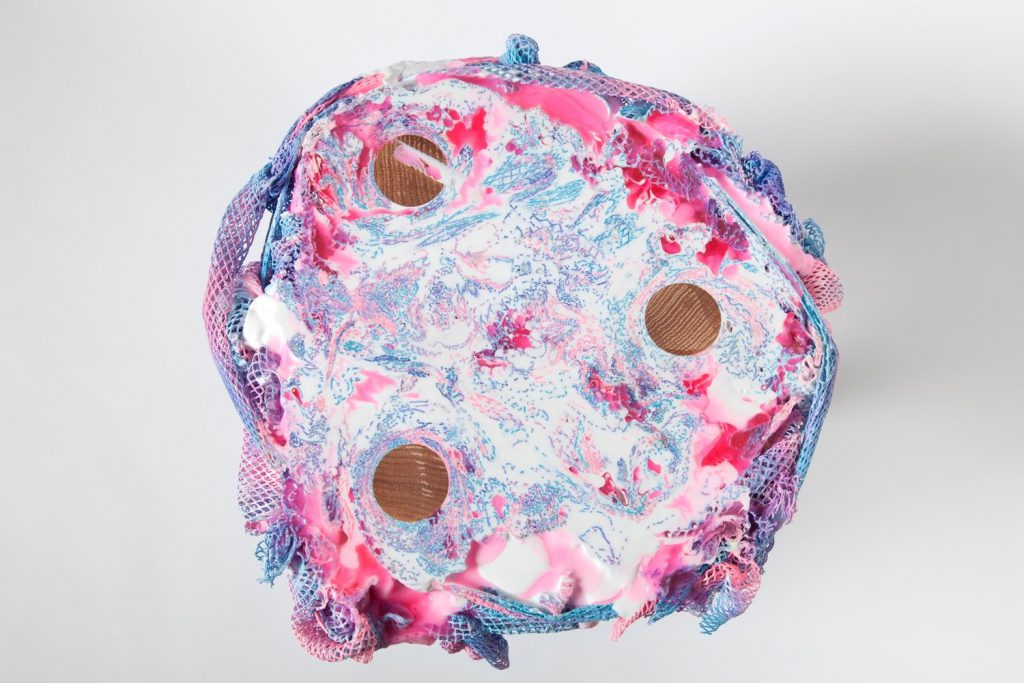
MJF: It’s funny, that comparison of design to craft—craft as fighting the material. One way your work relates to the modernist obsession with materiality is your obsession with following what the material wants to be naturally, even if that means fighting the material in the construction process to get it to be “what it wants to be.” There’s actually a kind of visual violence to much of your work: the slicing, the shards, the fragments; but in the end that’s really the more natural process.
C: For example, this thing, it’s just a netted bag with foam sprayed into it. Then, when you spray paint onto it, because these are convex surfaces, the surfaces actually want to pick up the paint, whereas the netted fabric does not want to pick up the paint. I couldn’t have made this happen if it didn’t want to be like that.
MJF: Right. I actually had wondered if you have been able to get spray foam in colors, as I’ve never seen that.
K: You can get foam that you can mix and then add colors.
MJF: But, I mean, that’s interesting that you just choose to work with the chemical processes as they happen.
K: Also, this stuff is just so un-UV-stable that you have to paint it no matter what, so we paint the material with a rubberized paint.
K: This has only got a couple layers on it.
C: Yeah, so it needs a couple more. But yeah, it’s kind of AMAZING to me that you can spray this and it can cover all the foam parts and then leave the color—I don’t think I could have thought that through.
MJF: Right, so was that something you found by chance or something you knew was going to work that way?
C: No! I was just like, “I gotta paint this!” So I just started spraying, and I was like, “If I dust this lightly it doesn’t have to pick up all of it.”
K: Well also, because it shrinks, traditional paint that’s not rubberized will flake off, and so it has to be made with rubber paint.
C: Yeah, but a lot of the way we design things is like, “Let’s just play around with it.” You can’t really think this through all the way, and know all the hurdles, so might as well just design as you go.
K: : Or like the chairs—the first three collapsed. It’s just faster to build a prototype then to model it and do physics tests on it. This is a really early block that we did and there's just a lot of nice stuff in it that has informed other pieces. You can find a nice moment and try to reproduce it.
MJF: There’s a certain kind of chemical alchemy here, in contrast to a lot other people who tend to focus on materials—a chemical unnaturalness, but in a way a simulation of natural materials. Are you intentionally trying to simulate marble or other natural materials at times?
K: Initially, we were doing stuff out of plastics and then we were like, "There’s a natural composite that we can use: stone." And then after doing stone for a while we decided to experiment (this is not a very interesting piece, but) with corian, which is, you know, the counter top material, a pre-made version of this, so it’s always about that back and forth.
C: Yeah, I feel like no matter what you kind of stumble upon yourself, once you start looking into it you realize there is this long history of people making exactly what you just invented yourself (laughing).
MJF: Totally.
K: I think, also, that when we started the weird maybe-toxicness of some of the materials, there was a lot of natural design going on that I think that we initially started pushing against.
MJF: I read something about your joke blog with all the toxic things.
C: Yeah, we tend to take contrarian position on things, so it was also just a way to separate yourself from the pack.
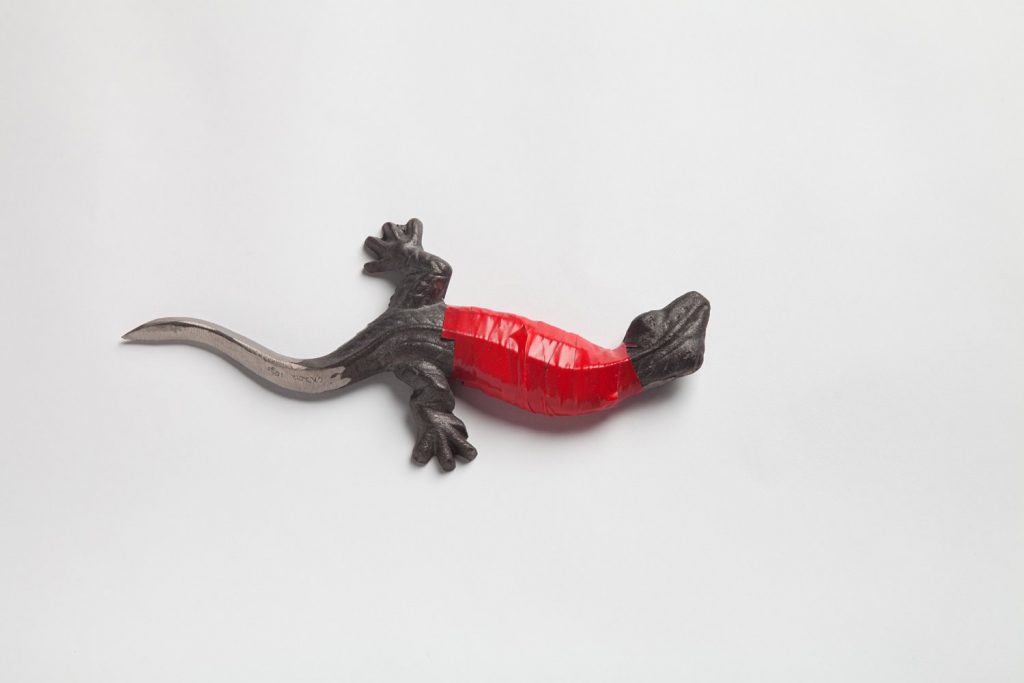
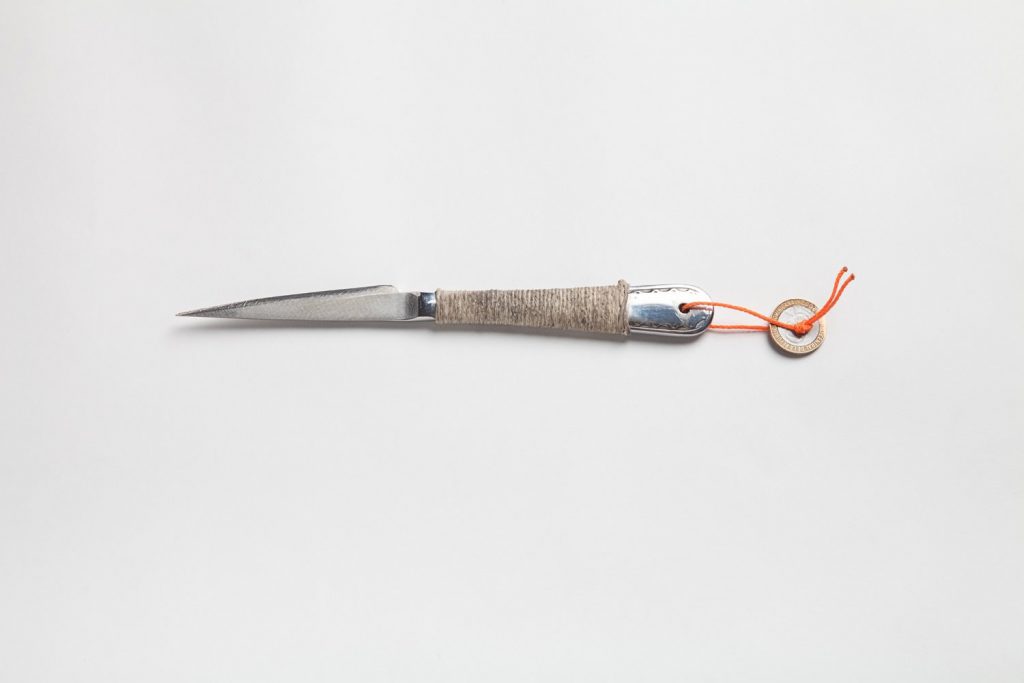
MJF: Is it being contrarian for the sake of being contrarian or is there actually something to it, something possibly more honest or even dishonest?
K: Its not to have other examples of stuff that your work should be like. I’d rather work in an area that’s open and not filled with other people making good decisions.
C: For us, it’s really not even about aesthetics at all. You can kind of see the same decision-making process, but that chair out there has aesthetically almost nothing to do with this. For us it’s really about what that object wants to be. When we decide that we want to make a chair, ok, so these are the materials that kind of form the thing.
MJF: So, does function or object always come first and materials come after?
C: For us, it has to be what it has to be. We are not really trying to take an aesthetic position.
MJF: So, when you make bangles and coasters, is it that you find a material and think, “this would make good coasters, ” or do you decide, “we want to make bangles and coasters”?
K: I think it’s not really one or the other. But one of the things I do always want to fight against is designers who won’t produce a good idea because they are too interested in keeping a certain aesthetic. That’s horrifying. Why would you do that?
MJF: Right, to sacrifice things for the body of work.
K: I’d rather make a project that I felt was good at the time or, you know, even a stupid project.
MJF: But obviously there does end up being narratives between these things and a lot of that is not function but material.
K: I think any connection is hopefully a natural connection because of the way we work, rather than [because of] some larger attempt to control the whole.
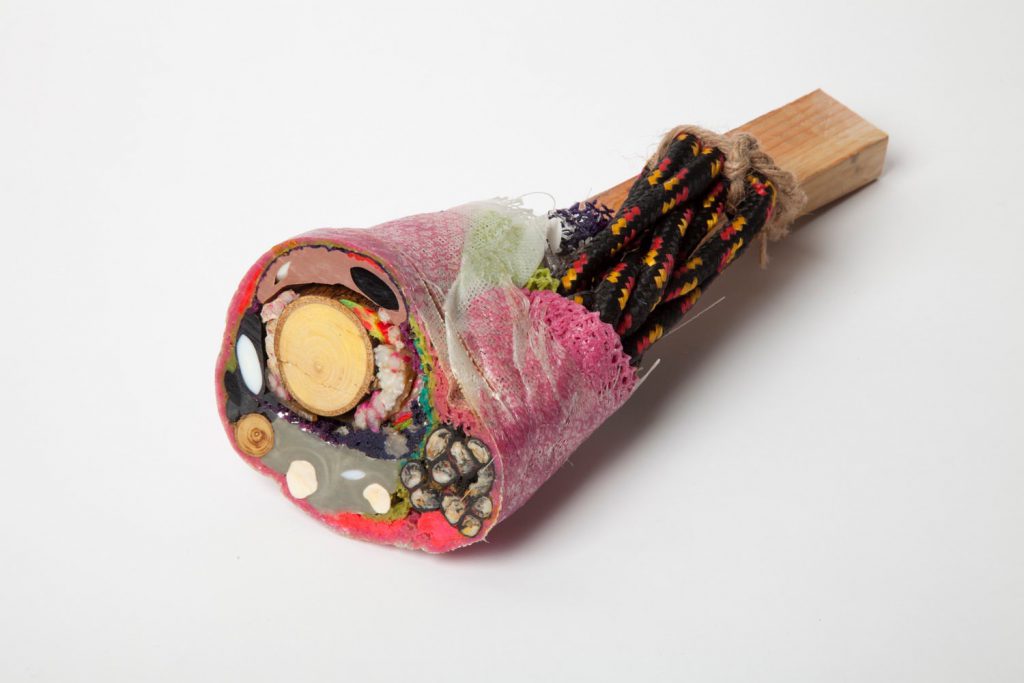
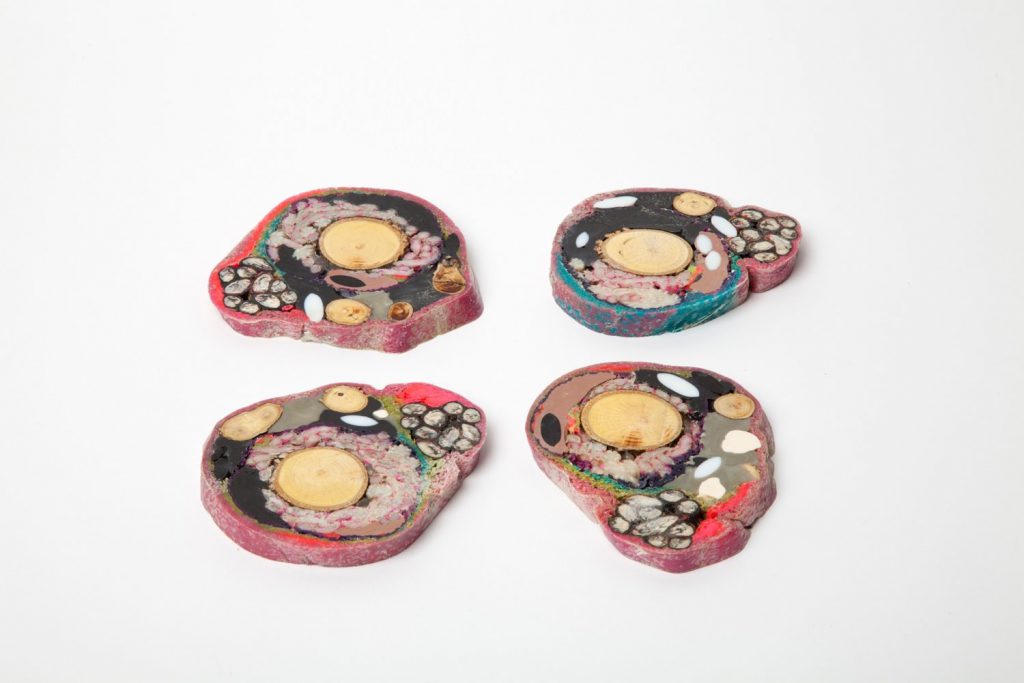
MJF: How important is accessibility? The ability to make something reasonably inexpensively so that people can have it and use it?
C: I think with the planters that was our main goal—to make something that was very easily accessible. It’s just like a simple thing that we can make here that has a lot of appeal and is priced very affordably.
K: That and, about a year ago, we were just walking around the NY art gift fair—which in a lot of ways is one of the worst places on earth—just full of total junk. It also became sort of a thing for us.
C: I think it’s easy to design things that are expensive.
K: Right.
MJF: Right, I think that’s why the fallback of wanting to have an experimental practice—same with a lot of art practices—becomes dependent on the mega-wealthy to afford what you make.
K: I think it’s very important to have that project. It’s a really hard problem to try to make something that costs like $3.00 in materials.
C: For something to retail for like $18.00 we have to make the material cost $1.50, $2.00. That is a difficult kind of problem to solve.
MJF: Part of the problem is solved because you can get a higher price for these things because they have designer-made kind of appeal. Do you think you’d be interested in making something that was mass produced or is that removed from your process too much?
K: I think we’re always interested in industrial processes, and if it was mass-produced I’d be interested in that as well, but one of the things we like doing is being able to make it for the first time ourselves.
C: We did this collaboration with Tai Ping carpets and they took our coasters and turned them into 4’ wide carpets, and that was like one of the first times where we didn’t have any tactile control over the thing. They would draw up the diagram of what everything was going to be, and then have these little samples. “This piece is going to look like this...” And you’re like, “Well, alright, I don’t really know what it’s going to look like...”
K: But that’s also an extremely non-industrial process going on there.
C: Yeah! But at the same time, whatever that carpet looks like from that process that is going to be used to make it, it’s the same philosophy. We don’t really have control over what this is going to look like. We can compose it, but I don’t really know what it’s going to look like until the last second when I cut into it.
K: We do try to compose it. I know that that one was made by me.

MJF: Well, most industrial processes remove the operations of chance, to take away the potential for one object to come out differently from the others.
C: But to the designer you’re letting go. We made this like, “I dunno, I think we might have hacked it...” We were working on this mask that has a stand and we had spec’d this stand and the factory was like, “We think this might work better and it’s easier to make.” And when it came back, we were like, “Oh yeah! That’s totally fine.” our philosophy is that it’s going to look like what it has to look like. We’re pretty good at letting go and letting the process happen...hopefully.
MJF: Obviously your parents [KaI’s parents, architects William/Tsien] are coming from this kind of phenomenological-sensuous relationship to material that is kind of precious. You’re obviously moving away from that. Is it a desire to create a different kind of sensuousness or is it intentionally grotesque? Is it an attempt to elevate toxic materials to the sensuous?
K: I think any of those materials have to speak to you. They have stricter clients that I have, but I think anyone that’s interested in materials can be interested in any of the materials. There is something grotesque about this, but I don’t think that it’s. . .
C: Yeah, it’s grotesque yet appealing at the same time. It’s almost like a dangerous object. You’re attracted yet repulsed by it at the same time. I think if you can illicit that kind of feeling, you’re obviously doing something right.
MJF: Right, like with the shanks being this dangerous ugly object, but at the same time the craftsmanship and the ingenuity is remarkable and strangely appealing.
K: I think making things on spec gives you incredible freedom that I like. Then you can find the audience that would buy this thing, rather than working to make something sensuous.
C: We’re not like the best craftsmen or anything. For us it’s about this, kind of, this Macgyver moment. You can take this bubblegum and stick it on this, and then this will happen, and there it is! That’s kind of an important aha moment. Everything we make has that. There’s that one moment where, for us, we’re excited when we see the end result. Like, wow, I cant believe that happened out of ... basically nothing. The materials for this cost about ten dollars. or making a bookend out of some rocks you found in the street— you put it in a very simple mold, and all of a sudden, it’s this very appealing object, but the final object kind of comes out on it’s own.
MJF: Then there’s possibility for your work to change just based on what kind of materials you end up finding, or what kind of chemicals and materials end up coming out. I’m always getting excited about new materials that are coming out. Have you guys seen NeverWet?
K&C: Yeah!
MJF: BLOWS MY MIND! It’s so good! Are there any recently engineered materials that you are excited about?
K: We’ve been sort of heads-down and just producing stuff for Christmas season, but I have been wanting to make stuff out of candy for a really long time. There’s all these materials, as were packing, like, “Ah shit, I got this years ago. We need to do something with this!” We had these cement chunks that I want to use...
C: They were drilling out spots to put posts for this fence next door.
K: It’s totally trash.
C: But they are these are totally beautiful objects.
MJF: It’s so pretty.
K: To drill it out, you have to anchor the drill in the concrete next to it. To produce that, it would be very expensive. I got all this shellac years ago because some-body gave me this bangle—which was a lacquer bangle. It’s this stuff that bugs produce, so it’s an early plastic. It’s an indian bangle, yellow-studded, fake diamonds. So we went out and bought all this stuff, and of course immediately afterwards... who was it.. ?
C: Oh yeah, Formafantasma! We bought all this shellac like, “Were going to do this!” and then the next day the press release came out for the Formafantasma Collection.
K: Exactly that same idea! I’m like, “Ahh, c’mon.” Studio Portable made a lacquer bangle with real industrial diamonds in it... I’m like, “dammit!” But I still want to do that stuff. There’s all these natural resins that we bought that I want to mess around with.
C: There’s also incense, like copal...
K: Frankincense and myrrh are also all-natural resins.
C: So they smell really great, but they’re like non-toxic plastics to mold.
MJF: Is toxicity or even non-toxcity at all interesting or not-interesting to you? It doesn’t seem like you really mind it so much either way.
K: It’s just another quality of the material.

MJF: Do you ever worry about getting cancer working with resin so much?
K: Yeah, I’d rather not work with resin for the rest of my life.
C: I’m like the safety nerd here. I cover up completely and wear like six layers of everything when I’m working with plastics. When we see something non-toxic that we can work with, we’re definitely chomping at the bit to use it.
K: Also, if you’re making anything, it’s not good for you. Wood dust is not good for you. Any kind of metal finishing is really bad for you. Blackening is terrible for you.
MJF: That’s one reason I was asking if you guys were interested in moving towards a situation where you were just making prototypes and having things manufactured. That’s always considered the trajectory: that when you’re young you do your own work, and then gradually you become more hands-off with your own work. But if you’re someone who really actually enjoys the process, and the process is so much of your actual design process, it seems difficult to move toward a practice where you’re more separated.
K: It’s true, but I am also obsessed with that industrial process of making things. It’s so cool.
C: For us, we’re like, that’s interesting but you want to move onto the next material. Ideally, I would love for someone to make these things for us because then it would also allow us to explore more things.
K: One of the other problems is that we keep on buying... like, “Oh! Lets get into making these stone things.” We can’t find a polisher that’s cheap enough. “Let’s just buy our own water polisher and do it ourselves.” And now we’ve got a whole stone area of the shop. We’ve got a metal area of the shop. We’ve got a wood area of the shop. We’ve got the plastic area—it’s just too much stuff. It’s a problem to keep producing all the stuff at once.
MJF: Then what is the direction that you think the new shop setup may go in then?
K: Initially, we started producing objects that are mid-range price, in that maybe they’re like $100-$300. If that’s mid price, I dunno. We’ve used that as mid price, and we’ve produced products that are less expensive products, which are basically like the stone planters. I think it’s better to have that range. I think always keeping a range of stuff is a really good thing, so I think we need to be concentrating on both the low- and high-ends.
C: Yeah, we have a bunch of things in the couple hundred dollars range. I think material-wise we’re really interested in the cement that we use for our planters. It performs really well. It sets fast. You can make it really thin. We’re making those dripping things with it, and I feel like that’s an interesting avenue.
K: I had a dream about this. I really want to combine these two materials, the fake and real stone.
C: Yeah, we did that table where we kind of laminated the two materials together, but I think we could do a lot more.
K: Bunch of ideas we haven’t gotten to, and we’re probably not going to get to for a while.
MJF: Keep wearing the masks when you work and you’ll get to them eventually. III